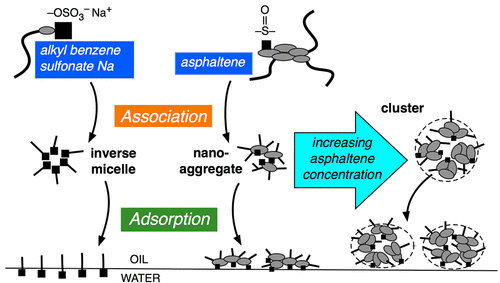当前位置:
X-MOL 学术
›
Energy Fuels
›
论文详情
Our official English website, www.x-mol.net, welcomes your
feedback! (Note: you will need to create a separate account there.)
Fundamental Basis for Action of a Chemical Demulsifier Revisited after 30 Years: HLDN as the Primary Criterion for Water-in-Crude Oil Emulsion Breaking
Energy & Fuels ( IF 5.2 ) Pub Date : 2022-01-03 , DOI: 10.1021/acs.energyfuels.1c03349
Jean-Louis Salager 1 , Ronald Marquez 1, 2 , Jose G. Delgado-Linares 1, 3 , Miguel Rondon 4 , Ana Forgiarini 1
Energy & Fuels ( IF 5.2 ) Pub Date : 2022-01-03 , DOI: 10.1021/acs.energyfuels.1c03349
Jean-Louis Salager 1 , Ronald Marquez 1, 2 , Jose G. Delgado-Linares 1, 3 , Miguel Rondon 4 , Ana Forgiarini 1
Affiliation

|
In the past four decades, many experimental studies have confirmed the systematic events occurring at the so-called optimum formulation of surfactant–oil–water systems. At this particular formulation, the adsorbed surfactant at the interface interacts equally with water and oil phases, which is supposed to occur according to Winsor theory to attain a three-phase behavior. A low minimum interfacial tension has been confirmed to take place at optimum in hundreds of reports on enhanced oil recovery (EOR). It also coincides with a very definite minimum in emulsion stability, which is looked after for chemical dehydration or crude oil desalting. A normalized hydrophilic–lipophilic deviation (HLDN) equation was proposed as a multivariable expression that numerically estimates the difference of the surfactant interactions with oil and water. This concept can be applied in crude oil emulsion breaking by considering asphaltenes as being in part a lipophilic surfactant whose effect must be compensated by a hydrophilic demulsifier surfactant to reach the optimum formulation. This is attained through equivalence effects by changing two or more variables, particularly asphaltenes and demulsifier type and concentration, which can be measured through different techniques. Furthermore, in recent studies, asphaltenes are found to exhibit two different lipophilicity levels depending on their self-gathering at or close to the interface, for example, as flat bidimensional nanoaggregates or as three-dimensional clusters. This review presents the know-how reached after 30 years of studying water-in-crude oil emulsion breaking (also known as chemical dehydration) using a formulation approach with the HLD multivariable expression. The first part reviews the fundamental concepts and advances on the HLD equation in relation to simple and complex mixtures. The second part presents several strategies aimed at increasing performance and decreasing demulsifier dosification using the HLDN normalized equation in a qualitative way as well as a quantitative way.
中文翻译:

30年后重新审视化学破乳剂作用的基本依据:HLDN作为原油包水破乳的主要标准
在过去的四十年中,许多实验研究证实了在所谓的表面活性剂-油-水系统的最佳配方中发生的系统性事件。在这个特定的配方中,界面上吸附的表面活性剂与水相和油相的相互作用相同,根据 Winsor 理论,这应该发生以获得三相行为。在数百份关于提高石油采收率 (EOR) 的报告中,已证实低的最小界面张力处于最佳状态。它还与非常明确的乳液稳定性最小值相吻合,用于化学脱水或原油脱盐。归一化的亲水-亲油偏差(HLD N) 方程被提出作为一个多变量表达式,它在数值上估计表面活性剂与油和水的相互作用的差异。这一概念可应用于原油破乳,将沥青质视为部分亲油表面活性剂,其效果必须由亲水破乳剂表面活性剂补偿以达到最佳配方。这是通过改变两个或多个变量(特别是沥青质和破乳剂的类型和浓度)的等效效应来实现的,这些变量可以通过不同的技术进行测量。此外,在最近的研究中,发现沥青质表现出两种不同的亲油性水平,这取决于它们在界面处或附近的自聚集,例如,作为平面二维纳米聚集体或作为三维簇。本综述介绍了使用具有 HLD 多变量表达式的配方方法研究原油包水破乳(也称为化学脱水)30 年后所获得的专有技术。第一部分回顾了与简单和复杂混合物相关的 HLD 方程的基本概念和进展。第二部分介绍了几种旨在使用 HLD 提高性能和减少破乳剂剂量的策略N归一化方程以定性方式和定量方式。
更新日期:2022-01-20
中文翻译:

30年后重新审视化学破乳剂作用的基本依据:HLDN作为原油包水破乳的主要标准
在过去的四十年中,许多实验研究证实了在所谓的表面活性剂-油-水系统的最佳配方中发生的系统性事件。在这个特定的配方中,界面上吸附的表面活性剂与水相和油相的相互作用相同,根据 Winsor 理论,这应该发生以获得三相行为。在数百份关于提高石油采收率 (EOR) 的报告中,已证实低的最小界面张力处于最佳状态。它还与非常明确的乳液稳定性最小值相吻合,用于化学脱水或原油脱盐。归一化的亲水-亲油偏差(HLD N) 方程被提出作为一个多变量表达式,它在数值上估计表面活性剂与油和水的相互作用的差异。这一概念可应用于原油破乳,将沥青质视为部分亲油表面活性剂,其效果必须由亲水破乳剂表面活性剂补偿以达到最佳配方。这是通过改变两个或多个变量(特别是沥青质和破乳剂的类型和浓度)的等效效应来实现的,这些变量可以通过不同的技术进行测量。此外,在最近的研究中,发现沥青质表现出两种不同的亲油性水平,这取决于它们在界面处或附近的自聚集,例如,作为平面二维纳米聚集体或作为三维簇。本综述介绍了使用具有 HLD 多变量表达式的配方方法研究原油包水破乳(也称为化学脱水)30 年后所获得的专有技术。第一部分回顾了与简单和复杂混合物相关的 HLD 方程的基本概念和进展。第二部分介绍了几种旨在使用 HLD 提高性能和减少破乳剂剂量的策略N归一化方程以定性方式和定量方式。































 京公网安备 11010802027423号
京公网安备 11010802027423号